of clean, safe and
unlimited energy

Corridor of the Institut de Recherche sur la Fusion par
confinement Magnétique in Cadarache, France
Energy from fusion is said to be always 30 years away.
Some of the scientist like to compare it to the building of a
church. The first, who laid the foundation in the 1950s, will
never see their seeking come to an end.
We don‘t create energy.
We only convert it from
one form to the other.
Greg de Temmerman
Managing director of Zenon research, a think tank
focussed on analysing innovations required to transition
to a low-carbon world.
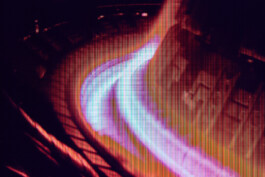
Camera image of plasma inside JET tokamak
Inside the sun hydrogen atoms fuse to helium under
conditions of high pressure and temperatures of million
degrees. Earths gravitational field is much smaller
than the suns. In order to make fusion happening on
earth even extremer conditions need to be created.
A fusion reactor has to be ten times hotter than the sun.
150,000,000 °Celsius.
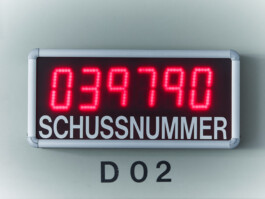
'Shot Number'

Wendelstein 7-X control room
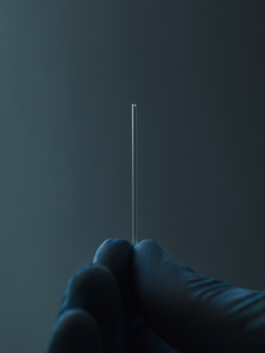
The most efficient reaction is the fusion of two hydrogen
isotopes deuterium and tritium.
Glas capillary containing 0.00016 gramm of tritium. Fused
it could release as much energy as 1.728 kilogramm of coal.
Therefore the fuel needed for a fusion power plant in a
year could fit inside a car. While a coal power plant with
equal power output consumes a whole train worth of fuel
every day.

Keith Taylor,
Shift Technician
In the 1960s, Russian scientists invented
a machine that they called 'tokamak'.
It uses enormous magnets to confine the
hot fusion plasma.
IPP Garching has Germany‘s largest tokamak
called ASDEX Upgrade.
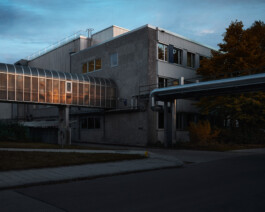


Mock-Up of a Wendelstein 7-A magnet
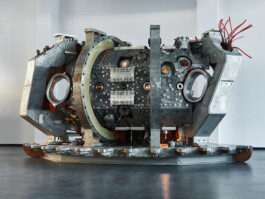
Wendelstein 7-A vessel with magnets

Cédric Reux,
Session Leader
The Session Leader
is like a conductor in
an orchestra.
He doesn‘t make the
music himself, but
makes sure everyone
plays along.
Cédric Reux,
Session Leader

The international science institute ITER
is build in St. Paul les Durance, France.
Its plasma is supposed to be the first to produce
ten times more energy than was needed
to run the reactor. Resulting in ITER being the
crucial proof of concept.

Door towards ITERs cryostat assembly hall
With more than 20 billion construction costs ITER is worlds
biggest research endeavour in the energy sector. The costs
are shared between 35 nations; representing 50 percent of
the world‘s population.

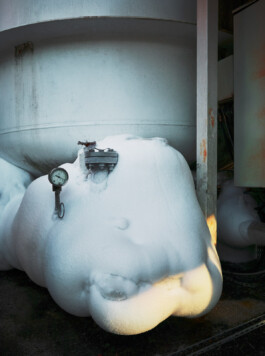
Vladimir Tronza,
Manufacturing and assembly engineer
Piping of a helium tank frozen due to
condensation of water on the cold surface.
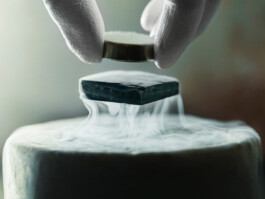
At -196.15 °Celsius a superconducting
magnet made of ReBCO becomes impermeable
for magnetic fields. In consequence
it’s pinned in between a permanent
magnets field lines. Called the Flux Pinning
phenomenon.
Liquid helium will be used to cool ITERs
magnets made of niobiumtitanium down
to four degrees over absolute zero. At this
temperature they conduct electricity without
resistance. Superconducting magnets consume
less power, are therefore cheaper to
operate and create a stronger magnetic field
than conventional counterparts.
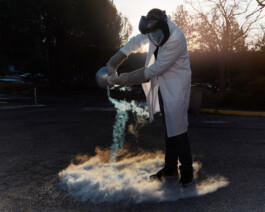
Quentin Gorit,
Post Doctoral Researcher, pouring liquid carbondioxide.
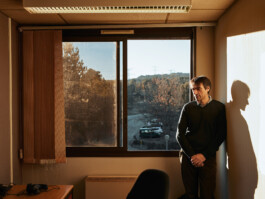
Jérôme Bucalossi,
Head of the Institute for Magnetic Fusion
Research (IRFM) in Cadarache, France

Diagnostics building of IRFM
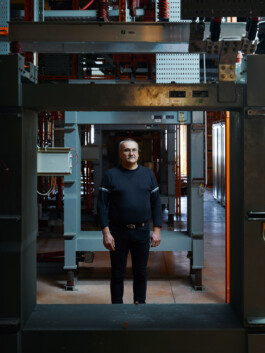

Patrick Martino,
Electrical Technician specialized in high power supplies.
Selfmade fuse protecting the magnets from
overvoltage.

Nathalie Bihan,
Financial and Commercial Manager
Trying to confine
plasma is like trying
to confine a doughnut
of marmelade with
ducttape.
Emmanuelle Tsitrone,
Plasma Physicist

ASDEX Upgrade blueprint
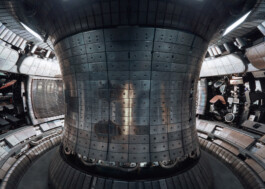
ASDEX Upgrade
Divertor tile molten during high heat load
experiments.
Unlike fission - in a fusion power plant, there
will be less than one gram of fuel in the
reactor at any given moment. In the event of
a total loss of power, the reaction would stop
in seconds, because constant heating and
confining are necessary to keep the process
going.
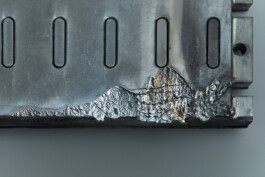
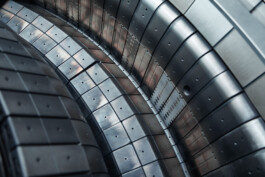

Divertor of ASDEX Upgrade
Albrecht Herrmann,
Former Group Head ASDEX Upgrade Enhancement
and Maintenance
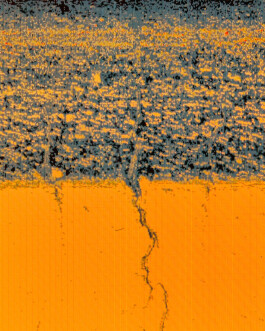
Laserscan of a damaged wall component
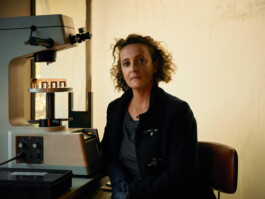
Marianne Richou,
Deputy Project Leader for tungsten divertor development
at EUROfusion
WEST tokamak tungsten coated divertor component
The divertor directs dust particles and other impurities
of the plasma out of the machine. ITER‘s divertor will have
to withstand the equivalent range of thermal heat flux as a
spaceshuttle tile had to endure while reentering earth atmosphere.
To minimize the detrimental effect of the
plasma, the material facing the plasma is tungsten.
It has the highest known melting point at 3,422 °Celsius
and a high resistance to erosion.
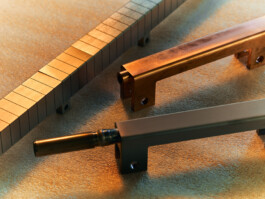

Tristan Raynal,
Measurement Engineer, inside WEST Tokamak
Fusion was the
closest to science
fiction that I could find.
Alexander Bock,
Post Doctoral Researcher
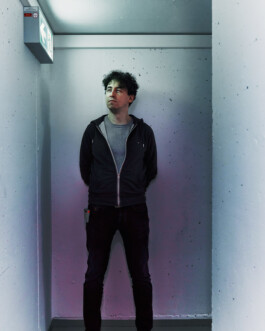
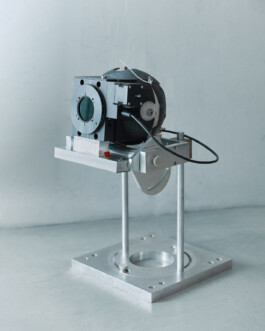
Alexander Bock,
Post Doctoral Researcher
Selfmade integrating sphere used to calibrate
instruments measuring the magnetic field of the
plasma.

ITER reactor pit
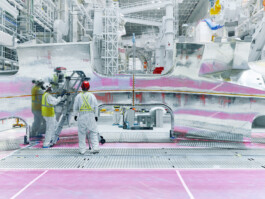
Silver coated thermal shield of ITER
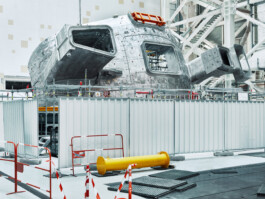
First of nine ITER vacuum vessel sectors
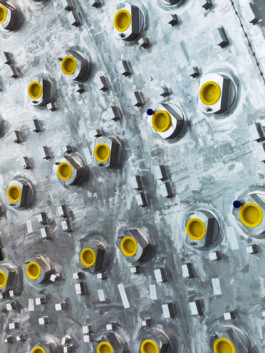
Connection points for the ITER blanket modules
Most power plants burn fuel in order to create heat, which
is then extracted by a coolant and used to run turbines and
generate electricity. The coolant in a fusion reactor also
fulfills this function while maintaining the plasma facing components at allowable temperature levels.

ITER cooling tower fan cylinders
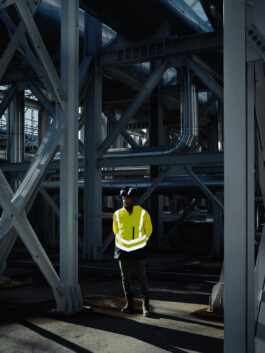
Alfonso Marquez,
Cooling water Installation Surveillance Section Leader
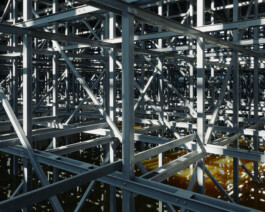
Cooling Tower support structure made of
fibre-reinforced polymer to prevent corrosion.

Shipping crates of new diagnostic instruments
Nine tenths of ITER components will be made off site. For
example Korea manufactures four and Europe five vacuum
vessel sectors. In this way, the scientific and industrial knowledge
is shared. After ITER most members will build their own
prototype power plant called DEMO.

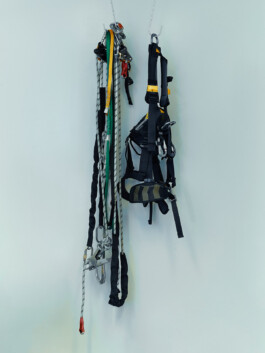
ITER assembly hall
Industrial climbing equipment

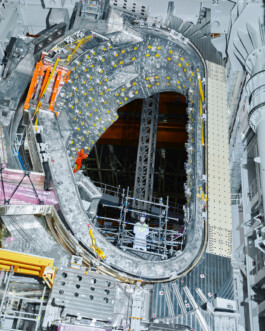
Chang-Ho Choi,
Head of the Sector Modules Delivery
and Assembly Division
ITERs first vacuum vessel with magnets
attached
Around four meters will be in between the 150,000,000 °Celsius
hot plasma and the -269 °Celsius cold magnets.

Tony Donné,
Head of EUROfusion
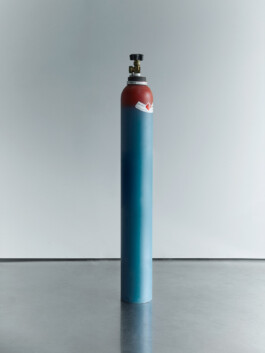
Deuterium gas bottle
In contrast to tritium – deuterium is a stable isotope
of hydrogen. About every 6,000 atom in sea water is deuterium.
At the moment around twenty kilogramm of tritium are
estimated to be available world wide. A 2,400 megawatt fusion
reactor would need as much as 134 kilogramm per year.
Due to the radioactive decay of tritium, if ITER would buy one
kilogramm tritium in 2022, less than 500 gramm would be
left in 2035.

No sufficient external source of tritium exists beyond ITER.
Making the successful development of a tritium source
essential for the future of fusion energy. Tritium can be
produced within the tokamak when neutrons escaping the
plasma interact with a blanket made of lithium.
To solve this problem Jaap van der Laan and his team
research this so called 'Tritium Breeding' at ITER.
I like neutrons.
Because when we
have neutrons, that
means we are having
fusion reactions
and we are creating
power.
Michael Loughlin,
Former Nuclear Analysist
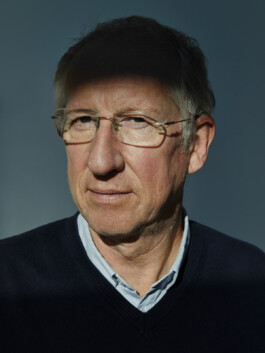
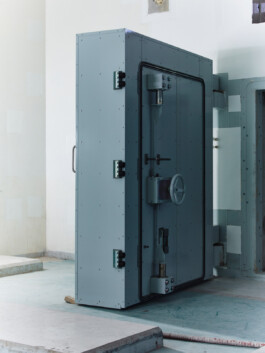
Bioshield door
Neutrons generated by the fusion reaction are so energetic that
would reach the moon in eight seconds. They can interfere with
atomic nucleus, which in return produce ionizing radiation. For
that reason people can‘t work inside any activated area.
Michael Loughlin,
Former Nuclear Analysist

Floor markings at ASDEX Upgrade
security gate

Glove Boxes at UKAEA Material Research Facility
Radioactive waste from fusion power plants could be
released after a 100 years or used in new plants by applying
suitable wall materials. Nuclear fission reactors, on the other
hand, produce highly radioactive waste with half-lives of
more than 10,000 years in some cases, which is why final
disposal is necessary.
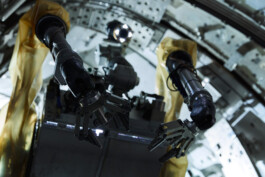
Robotic manipulator MASCOT inside JET
at UK Atomic Energy Athority (UKAEA)
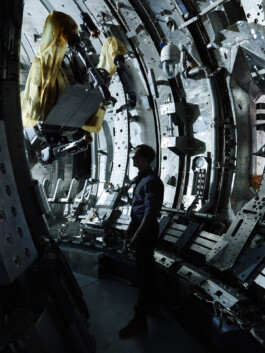
Fred Rose,
Post Doctoral Researcher

Robotic hand of MASCOT supposed to mimic the
movement of the operators hand.
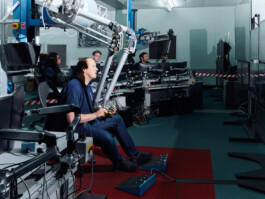
Remote handling control room at UKAEA
The JET MASCOT system enables engineers
to perform maintanance tasks inside the reactor
remotely. The movement of two controllers
is mirrored by the robotic arms. When a bolt
is tightened the torque will be simulated.
Providing a limited amount of haptic feedback
for the operator.
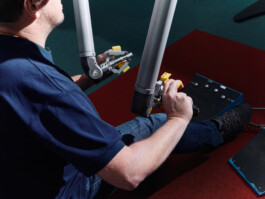

Operator holding the controllers mirrored by the robot.
Multiple screens display all information
to the operator and the team.
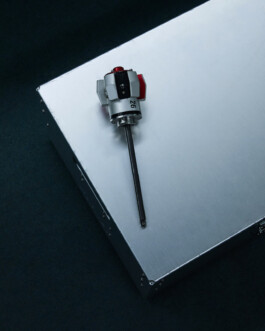
Robotic tool developed for the MASCOT hands
to tighten bolts.
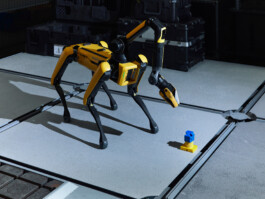

Boston Dynamics robot 'Spot'
Emergency stop button of an experiment with robots
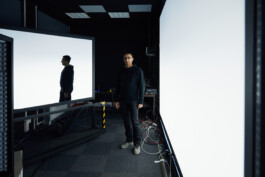
Stephane Gazzotti,
Computing and XR Research Engineer

Sunny Hongjuan,
JET Session Leader
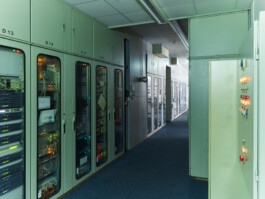
ASDEX Upgrade servers

Graph on synchronisation phenomena in plasma turbulence

Sara Moradi,
Plasma Physicist

Wendelstein 7-X
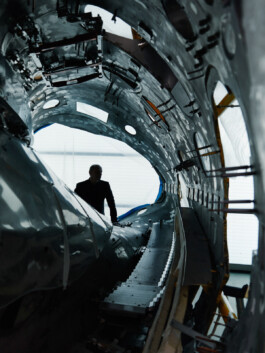
Thomas Klinger,
Head of Wendelstein 7-X
Wendelstein 7-X is the worlds biggest stellarator.
Its magnetic field has been computer calculated in order
to optimally confine the plasma. Stellarators therefore
have an asymmetrical shape, which makes them harder
to build, but more efficient to operate.
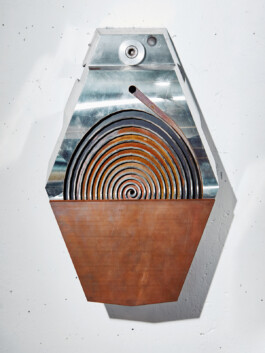
Water cooled microwave heating system mirror

Microwave channel at Wendelstein 7-X
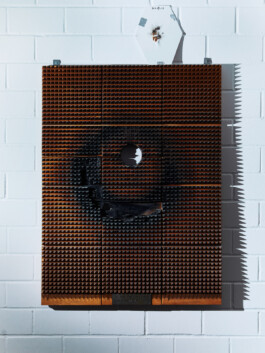
Microwave channel at Wendelstein 7-X
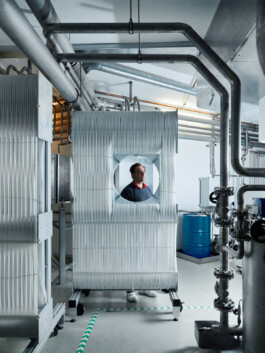
Dmitry Moseev,
Plasma Heating Research Scientist
Wendelstein 7-X heating power of 10 Megawatt compares to
that of 10,000 conventional microwaves. Ten so called Gyrotrons
produce the power, which is directed into the reactor
by mirrors. Small imperfections might scatter some of the
microwaves. To protect the concrete from being damaged
watercooled teflon tubes absorbe the misled waves.
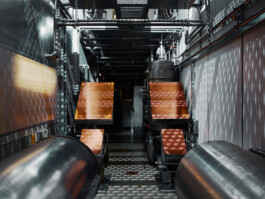
Microwave channel at Wendelstein 7-X
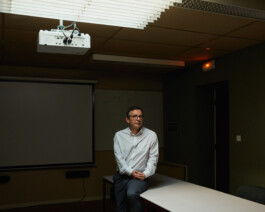
Xavier Litaudon,
Project Leader Preparation of ITER Operation
at CEA and EUROfusion

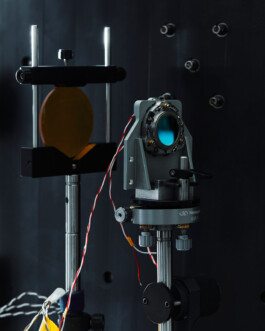
The neutron bombardment and heat inside the reactor is a hostile environment to all delicate diagnostics systems. Therefore most of the measurements are made by observing particles and electromagnetic rays emitted by the plasma and by the heated first wall of the tokamak.
Léo Dubus,
Infrared Instrumentation Engineer
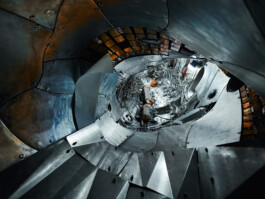
Wendelstein 7-X vacuum chamber
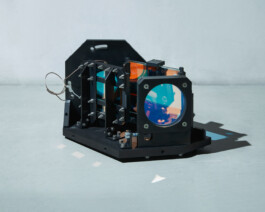
Periscope of IMSE diagnostic system measuring
the magnetic field of the plasma at ASDEX Upgrade.
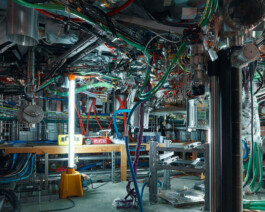
Underneath british fusion reactor MAST Upgrade
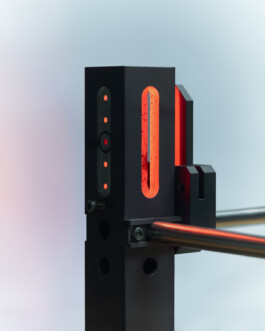
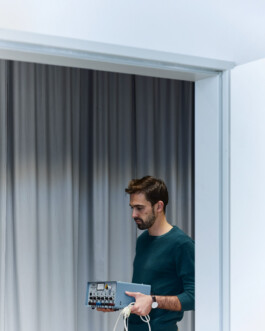
Neon lamp used to calibrate diagnostics.
Davide Silvagni,
Post Doctoral Researcher
Fusion is the little,
vegan brother of
fission.
Mohammed Behorma,
Former EUROfusion Officer
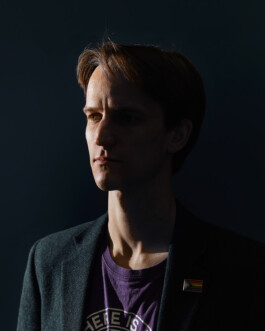
Nicholas Hawker’s research on fusion began in 2007 as
part of his masters’ thesis, where he worked at the university
of Oxford with Yiannis Ventikos.
In 2011 First Light Fusion was founded with Nick being
the CEO to research the prospect of a fusion power plant
using inertial confinement. Their approach is to trigger
the reaction by heating and compressing a fuel capsule
enough to reach the required temperatures and densities.

Metal plate penetrated by a projectile.

Gunpowder storage
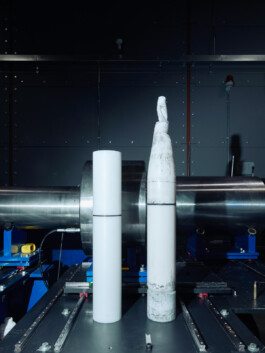
Gas gun piston
In their testing device 'BFG', First Light Fusion is accelerating
a projectile to seven kilometers per second using
3 kilogramm of gunpowder inside a 2-stage gas gun.

In order to reach the high velocities necessary for fusion,
'Machine 3' uses electromagnetic forces to accelerate
a projectile to 20 kilometer per second. A potential
inertial fusion power plant will work like a combustion
engine. Compressing and sparking fuel in a repetitive
process.
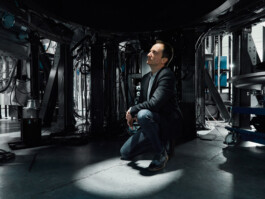
Gianluca Pisanello formerly worked as
an Formula One Chief engineer. Now he is the
Chief Operating Officer of First Light Fusion.

Target with two spherical shockwave amplifiers
and a fuel capsule
About 99 percent of
the universe around
us is plasma.
Earth is one of the
few places where
plasma does almost
not exist naturally.
Emmanuelle Tsitrone,
Plasma Physicist
The Promise
2023
of clean, safe and
unlimited energy

Corridor of the Institut de Recherche sur la Fusion par
confinement Magnétique in Cadarache, France
Energy from fusion is said to be always 30 years away.
Some of the scientist like to compare it to the building of a
church. The first, who laid the foundation in the 1950s, will
never see their seeking come to an end.
We don‘t create energy.
We only convert it from
one form to the other.
Greg de Temmerman
Managing director of Zenon research, a think tank
focussed on analysing innovations required to transition
to a low-carbon world.

Camera image of plasma inside JET tokamak
Inside the sun hydrogen atoms fuse to helium under
conditions of high pressure and temperatures of million
degrees. Earths gravitational field is much smaller
than the suns. In order to make fusion happening on
earth even extremer conditions need to be created.
A fusion reactor has to be ten times hotter than the sun.
150,000,000 °Celsius.

'Shot Number'

Wendelstein 7-X control room

The most efficient reaction is the fusion of two hydrogen
isotopes deuterium and tritium.
Glas capillary containing 0.00016 gramm of tritium. Fused
it could release as much energy as 1.728 kilogramm of coal.
Therefore the fuel needed for a fusion power plant in a
year could fit inside a car. While a coal power plant with
equal power output consumes a whole train worth of fuel
every day.

Keith Taylor,
Shift Technician

In the 1960s, Russian scientists invented
a machine that they called 'tokamak'.
It uses enormous magnets to confine the
hot fusion plasma.
IPP Garching has Germany‘s largest tokamak
called ASDEX Upgrade.


Mock-Up of a Wendelstein 7-A magnet

Wendelstein 7-A vessel with magnets

Cédric Reux,
Session Leader
The Session Leader
is like a conductor in
an orchestra.
He doesn‘t make the
music himself, but
makes sure everyone
plays along.
Cédric Reux,
Session Leader

The international science institute ITER
is build in St. Paul les Durance, France.
Its plasma is supposed to be the first to produce
ten times more energy than was needed
to run the reactor. Resulting in ITER being the
crucial proof of concept.

Door towards ITERs cryostat assembly hall
With more than 20 billion construction costs ITER is worlds
biggest research endeavour in the energy sector. The costs
are shared between 35 nations; representing 50 percent of
the world‘s population.

Piping of a helium tank frozen due to condensation of water on the cold surface.

Vladimir Tronza,
Manufacturing and assembly engineer

At -196.15 °Celsius a superconducting
magnet made of ReBCO becomes impermeable
for magnetic fields. In consequence
it’s pinned in between a permanent
magnets field lines. Called the Flux Pinning
phenomenon.
Liquid helium will be used to cool ITERs
magnets made of niobiumtitanium down
to four degrees over absolute zero. At this
temperature they conduct electricity without
resistance. Superconducting magnets consume
less power, are therefore cheaper to
operate and create a stronger magnetic field
than conventional counterparts.

Quentin Gorit,
Post Doctoral Researcher, pouring liquid carbondioxide.

Jérôme Bucalossi,
Head of the Institute for Magnetic Fusion
Research (IRFM) in Cadarache, France

Diagnostics building of IRFM

Patrick Martino,
Electrical Technician specialized in high power supplies.

Selfmade fuse protecting the magnets from overvoltage.

Nathalie Bihan,
Financial and Commercial Manager
Trying to confine
plasma is like trying
to confine a doughnut
of marmelade with
ducttape.
Emmanuelle Tsitrone,
Plasma Physicist

ASDEX Upgrade blueprint

ASDEX Upgrade

Divertor tile molten during high heat load
experiments.
Unlike fission - in a fusion power plant, there
will be less than one gram of fuel in the
reactor at any given moment. In the event of
a total loss of power, the reaction would stop
in seconds, because constant heating and
confining are necessary to keep the process
going.

Albrecht Herrmann,
Former Group Head ASDEX Upgrade Enhancement
and Maintenance

Divertor of ASDEX Upgrade

Laserscan of a damaged wall component

Marianne Richou,
Deputy Project Leader for tungsten divertor development at EUROfusion

WEST tokamak tungsten coated divertor component
The divertor directs dust particles and other impurities
of the plasma out of the machine. ITER‘s divertor will have
to withstand the equivalent range of thermal heat flux as a
spaceshuttle tile had to endure while reentering earth atmosphere.
To minimize the detrimental effect of the
plasma, the material facing the plasma is tungsten.
It has the highest known melting point at 3,422 °Celsius
and a high resistance to erosion.

Tristan Raynal,
Measurement Engineer, inside WEST Tokamak
Fusion was the
closest to science
fiction that I could find.
Alexander Bock,
Post Doctoral Researcher


Alexander Bock,
Post Doctoral Researcher
Selfmade integrating sphere used to calibrate instruments measuring the magnetic field of the plasma.

ITER reactor pit

Silver coated thermal shield of ITER

First of nine ITER vacuum vessel sectors

Connection points for the ITER blanket modules
Most power plants burn fuel in order to create heat, which
is then extracted by a coolant and used to run turbines and
generate electricity. The coolant in a fusion reactor also
fulfills this function while maintaining the plasma facing components at allowable temperature levels.

ITER cooling tower fan cylinders

Alfonso Marquez,
Cooling water Installation Surveillance Section Leader

Cooling Tower support structure made of
fibre-reinforced polymer to prevent corrosion.

Shipping crates of new diagnostic instruments
Nine tenths of ITER components will be made off site. For
example Korea manufactures four and Europe five vacuum
vessel sectors. In this way, the scientific and industrial knowledge
is shared. After ITER most members will build their own
prototype power plant called DEMO.

Industrial climbing equipment

ITER assembly hall
Around four meters will be in between the 150,000,000 °Celsius
hot plasma and the -269 °Celsius cold magnets.


Chang-Ho Choi,
Head of the Sector Modules Delivery and Assembly Division
ITERs first vacuum vessel with magnets attached

Tony Donné,
Head of EUROfusion

Deuterium gas bottle
In contrast to tritium – deuterium is a stable isotope
of hydrogen. About every 6,000 atom in sea water is deuterium.
At the moment around twenty kilogramm of tritium are
estimated to be available world wide. A 2,400 megawatt fusion
reactor would need as much as 134 kilogramm per year.
Due to the radioactive decay of tritium, if ITER would buy one
kilogramm tritium in 2022, less than 500 gramm would be
left in 2035.

No sufficient external source of tritium exists beyond ITER.
Making the successful development of a tritium source
essential for the future of fusion energy. Tritium can be
produced within the tokamak when neutrons escaping the
plasma interact with a blanket made of lithium.
To solve this problem Jaap van der Laan and his team
research this so called 'Tritium Breeding' at ITER.
I like neutrons.
Because when we
have neutrons, that
means we are having
fusion reactions
and we are creating
power.
Michael Loughlin,
Former Nuclear Analysist
Neutrons generated by the fusion reaction are so energetic that
would reach the moon in eight seconds. They can interfere with
atomic nucleus, which in return produce ionizing radiation.
For that reason people can‘t work inside any activated area.


Michael Loughlin,
Former Nuclear Analysist
Bioshield door

Floor markings at ASDEX Upgrade
security gate

Glove Boxes at UKAEA Material Research Facility
Radioactive waste from fusion power plants could be
released after a 100 years or used in new plants by applying
suitable wall materials. Nuclear fission reactors, on the other
hand, produce highly radioactive waste with half-lives of
more than 10,000 years in some cases, which is why final
disposal is necessary.

Robotic manipulator MASCOT inside JET
at UK Atomic Energy Athority (UKAEA)

Fred Rose,
Post Doctoral Researcher

Robotic hand of MASCOT supposed to mimic the
movement of the operators hand.

Remote handling control room at UKAEA
The JET MASCOT system enables engineers
to perform maintanance tasks inside the reactor
remotely. The movement of two controllers
is mirrored by the robotic arms. When a bolt
is tightened the torque will be simulated.
Providing a limited amount of haptic feedback
for the operator.


Operator holding the controllers mirrored by the robot.
Multiple screens display all information to the operator and the team.

Robotic tool developed for the MASCOT hands
to tighten bolts.


Boston Dynamics robot 'Spot'
Emergency stop button of an experiment with robots

Stephane Gazzotti,
Computing and XR Research Engineer

Sunny Hongjuan,
JET Session Leader

ASDEX Upgrade servers

Graph on synchronisation phenomena in plasma turbulence

Sara Moradi,
Plasma Physicist

Wendelstein 7-X

Thomas Klinger,
Head of Wendelstein 7-X
Wendelstein 7-X is the worlds biggest stellarator.
Its magnetic field has been computer calculated in order
to optimally confine the plasma. Stellarators therefore
have an asymmetrical shape, which makes them harder
to build, but more efficient to operate.

Water cooled microwave heating system mirror

Microwave channel at Wendelstein 7-X

Microwave channel at Wendelstein 7-X

Dmitry Moseev,
Plasma Heating Research Scientist
Wendelstein 7-X heating power of 10 Megawatt compares to
that of 10,000 conventional microwaves. Ten so called Gyrotrons
produce the power, which is directed into the reactor
by mirrors. Small imperfections might scatter some of the
microwaves. To protect the concrete from being damaged
watercooled teflon tubes absorbe the misled waves.

Microwave channel at Wendelstein 7-X

Xavier Litaudon,
Project Leader Preparation of ITER Operation
at CEA and EUROfusion

The neutron bombardment and heat inside the reactor is a hostile environment to all delicate diagnostics systems. Therefore most of the measurements are made by observing particles and electromagnetic rays emitted by the plasma and by the heated first wall of the tokamak.

Léo Dubus,
Infrared Instrumentation Engineer

Wendelstein 7-X vacuum chamber

Periscope of IMSE diagnostic system measuring
the magnetic field of the plasma at ASDEX Upgrade.

Underneath british fusion reactor MAST Upgrade


Neon lamp used to calibrate diagnostics.
Davide Silvagni,
Post Doctoral Researcher
Fusion is the little,
vegan brother of
fission.
Mohammed Behorma,
Former EUROfusion Officer

Nicholas Hawker’s research on fusion began in 2007 as
part of his masters’ thesis, where he worked at the university
of Oxford with Yiannis Ventikos.
In 2011 First Light Fusion was founded with Nick being
the CEO to research the prospect of a fusion power plant
using inertial confinement. Their approach is to trigger
the reaction by heating and compressing a fuel capsule
enough to reach the required temperatures and densities.

Metal plate penetrated by a projectile.

Gunpowder storage

Gas gun piston
In their testing device 'BFG', First Light Fusion is accelerating
a projectile to seven kilometers per second using
3 kilogramm of gunpowder inside a 2-stage gas gun.
In order to reach the high velocities necessary for fusion,
'Machine 3' uses electromagnetic forces to accelerate
a projectile to 20 kilometer per second. A potential
inertial fusion power plant will work like a combustion
engine. Compressing and sparking fuel in a repetitive
process.


Gianluca Pisanello formerly worked as
an Formula One Chief engineer. Now he is the
Chief Operating Officer of First Light Fusion.

Target with two spherical shockwave amplifiers
and a fuel capsule
About 99 percent of
the universe around
us is plasma.
Earth is one of the
few places where
plasma does almost
not exist naturally.
Emmanuelle Tsitrone,
Plasma Physicist